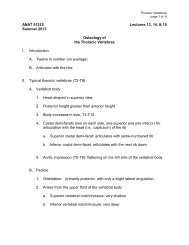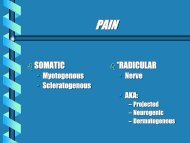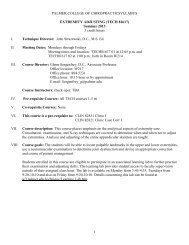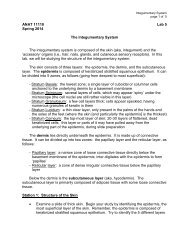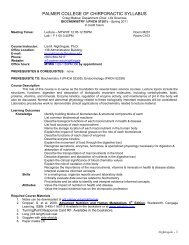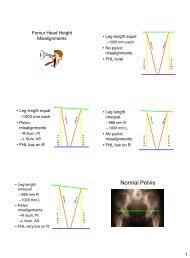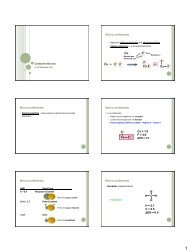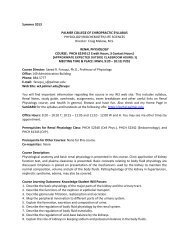POISE-SkyLite User Guide - Palmer College of Chiropractic, Intranet ...
POISE-SkyLite User Guide - Palmer College of Chiropractic, Intranet ...
POISE-SkyLite User Guide - Palmer College of Chiropractic, Intranet ...
You also want an ePaper? Increase the reach of your titles
YUMPU automatically turns print PDFs into web optimized ePapers that Google loves.
INTRODUCTION CHAPTER 1<br />
In order for a terminal to communicate successfully with a host, the terminal must speak<br />
the same language as the host. Terminal emulation s<strong>of</strong>tware such as <strong>SkyLite</strong> enables the<br />
PC to do this. It allows a PC to act like a particular brand <strong>of</strong> terminal, for example a<br />
VT320. The PC appears as a terminal to the host computer and accepts the same escape<br />
sequences for functions such as cursor positioning and clearing the screen.<br />
A terminal emulator enables you to connect to one or more hosts across different<br />
networks using many different emulations. To enable your terminal emulator to connect<br />
to a host across a network, you need to have the correct protocol s<strong>of</strong>tware loaded onto<br />
both your PC and the host. Protocol s<strong>of</strong>tware, <strong>of</strong>ten called a stack, gives your PC the<br />
right information to be able to send data across a network. The host also needs to have<br />
protocol s<strong>of</strong>tware to be able to interpret the data.<br />
A protocol is a set <strong>of</strong> formal rules, rather like a language, which enables communications<br />
between hosts and PCs. TCP/IP is a common protocol used with <strong>SkyLite</strong>.<br />
Note: Choosing the WinSock network option in <strong>SkyLite</strong> allows your PC to talk to the<br />
TCP/IP, as long as your host has the correct s<strong>of</strong>tware.<br />
When you make a connection to a host from your PC using <strong>SkyLite</strong>, you open what is<br />
called a session. In <strong>SkyLite</strong>, you can create a new session, save a session, open an existing<br />
session, have more than one session running at once, and switch between open sessions.<br />
This is much like opening a new file.<br />
When you create a new session, you have to tell <strong>SkyLite</strong> which s<strong>of</strong>tware protocol you<br />
have installed on your PC and the host, and which emulation you are using.<br />
Getting Started<br />
The following sections <strong>of</strong> this chapter give you an overview <strong>of</strong> <strong>SkyLite</strong>’s features, and the<br />
other chapters deal with <strong>SkyLite</strong> in more detail.<br />
If you want to dive straight in, turn to the Quick Start Section on page 9.<br />
<strong>SkyLite</strong> Features<br />
<strong>SkyLite</strong> brings data from host applications into your familiar Windows- and DOS- based<br />
spreadsheets, word processors and other programs. Using <strong>SkyLite</strong> as a terminal emulator,<br />
you can achieve connectivity immediately. However, <strong>SkyLite</strong> is not just a terminal<br />
emulator. It is easy to install and configure, disguising the sophistication <strong>of</strong> the solution.<br />
Once you’re set up, it’s simple and intuitive to use.<br />
You can configure host session files and save them for reuse by all users across LANs.<br />
Sessions are network links between your computer and remote hosts.<br />
The following topics describe some <strong>of</strong> the features <strong>of</strong> <strong>SkyLite</strong>.<br />
See page 57.<br />
See page 32.<br />
Hotspots<br />
A hotspot is text on the screen that has been programmed into the host application so<br />
that when you move the mouse pointer over the text and click the right button, a<br />
particular function is activated. You can use hotspots to add mouse pointer positioning<br />
with a full screen editor, and you can add the ability to point and click on words and<br />
functions on the screen.<br />
These features need to be configured on your PC and do not require any changes to the<br />
host program.<br />
Customizing Your Keyboard<br />
You can customize your keyboard by using the Keyboard Mapping option to define<br />
functions for PC keys pressed. You can also map keys to macros or specific character<br />
strings.<br />
8 <strong>POISE</strong>-<strong>SkyLite</strong> <strong>User</strong> <strong>Guide</strong>



